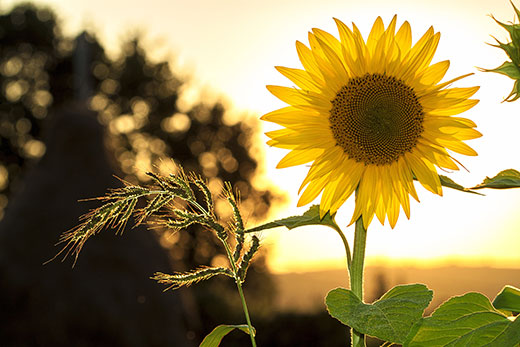Manhattan, Kansas, USA
September 3, 2020

Kansans’ pride in the sunflower goes well beyond their state’s catchy nickname.
Along with their beauty, sunflowers can produce an abundance of flavorful seeds and nuts that bring the fun from the garden into the kitchen. Kansas State University horticulture expert Ward Upham said mid-September into October is the best time to harvest those seeds.
“Seed heads can ripen right on the plant, but they will need protection from the birds,” Upham said. “Try covering the heads with a paper sack or cheesecloth once the petals start turning brown, then use a twist tie or rubber band to secure the covering.”
Covering the plant’s head will not only keep the birds from stealing the harvest, it will also prevent the ripened seeds from dropping out of the head, according to Upham.
He added that home gardeners can look for the following signs that seeds are mature:
- Florets in the brown center of the flower disk are shriveled.
- The head of the plant has turned downward.
- The back side of the head is a lemon yellow color.
“The ultimate check, of course, is to pull a few seeds to see if they have turned black with white stripes, which is the typical color,” Upham said. “Empty shells usually indicate a lack of pollination earlier in the year.
“If the heads remain uncovered, harvest the seeds when they begin turning black and white. The flavor will not be as good as when the seeds are allowed to ripen on the plants, but you’ll lose fewer seeds.”
When harvesting the sunflower, Upham suggests cutting the head of the plant and place it in a paper sack. “Some people prefer to cut the heads with about a foot of stem attached, then hanging them upside down in a dry, well-ventilated area,” he said.
Once the head is dry, Upham noted, seeds can easily be removed by rubbing gently on the surface of the head.
Roasting sunflower seeds
Upham’s advice for roasting sunflower seeds includes placing seeds in a pan and covering them with salted water – approximately two quarts of water to anywhere from ¼ to 2 cups of salt.
Bring the water to a boil and simmer for two hours, or soak the seeds in the salt solution overnight. Drain and dry the seeds on absorbent paper.
Once dried, the seeds can be cooked in a shallow pan in a 300 degree F oven for 30-40 minutes or until golden brown, stirring occasionally.
Then, he said, add one teaspoon of melted butter or margarine or cooking oil per one cup of seeds if they are to be eaten immediately. Stir to coat and then salt to taste.
Upham and his colleagues in K-State’s Department of Horticulture and Natural Resources produce a weekly Horticulture Newsletter with tips for maintaining gardens and home landscapes. The newsletter is available to view online or can be delivered by email each week.
Interested persons can also send their garden- and yard-related questions to Upham at wupham@ksu.edu, or contact your local K-State Research and Extension office.